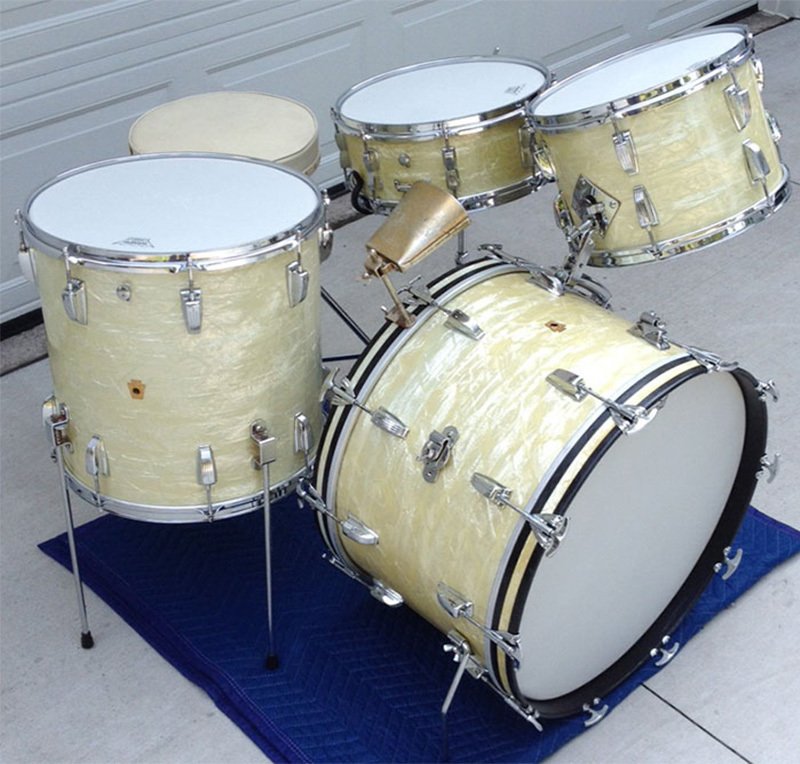Enter the Temple of Boom: Acoustic Kicks

Late last year, David Abravanel took us on a journey through the history of the electronic kick drum. Now, he’s back with a look at acoustic kicks. This article also features insights from Abe Seiferth, a producer, engineer, and musician whose credits include Yeasayer, Neon Indian, RAC, and many others.
The thud. The boom. The weight. The anchor.
In the modern drum kit, the kick drum is a focal point for the low end, and often a key keeper of time. It’s also a grounding force for the rhythm section. Sometimes there are tricky kicks – just check out any metal drummer with a double-kick pedal – but it’s still a centering force of gravity for any modern percussion part.
How did we get to the modern kick? How do we record and mix a kick? How do we make sure the kick sits properly in a track? In this piece, we’ll learn more about the evolution of the acoustic kick, look at some classic examples, and see how we can use the tools in Ableton Live to get excellent-sounding acoustic kicks that sit well in a mix.
In the beginning, there were big drums
Historically, the modern kick drum is descended from any number of large bass-register drums. In orchestral music, the timpani provides tuned bass percussion – watch and listen as New York Philharmonic percussionist Markus Rhoten demonstrates these rumbling beasts:
Meanwhile, classical Japanese music features Taiko drumming (“Taiko” is Japanese for “big drum”). Taiko is normally performed in ensemble, and can be recreated in Live with the Japanese Taiko Percussion pack from Sonica. Elsewhere, across the Middle East and North Africa, Ottoman “long drums” were similarly large, bassy instruments; some are still used today in traditional Mehter bands
Core of the kit
The modern kick drum is a central part of the drum kit, a configured set of drums used across multiple genres. While early drum kits were used in some marching bands, it was the advent of early jazz music in the 1910s that first introduced the sit-down drum kit that we’re accustomed to today.
It’s important to remember that, in the early heyday of New Orleans-style jazz (late 1910s/early 1920s), music was still largely an acoustic matter. Radios were an extravagance (and a non-portable one at that), while home listening formats were similarly expensive and, without the aid of electronic amplification, very low-fidelity. In this era, the kick drum was acoustically ideal for its loud presence in concert spaces. Live amplification was still a luxury, making it more necessary for ensembles to be acoustically balanced.
The recording revolution and kick reverb boom
Skip forward a couple decades to the 1960s, and home recordings had become big business. With innovations in electronic duplication of music had come similar developments in studio technology, with improving microphone models and early EQs and compressors providing better and better fidelity for recordings. Still, it was a challenge to record a clear, booming kick drum in a way that mirrored the weight and presence it would carry in a live setting.
With 1963’s “Be My Baby” by the Ronettes, legendary producer Phil Spector introduced his “wall of sound” production signature, which included a famously boomy and reverberated acoustic kick drum sound anchoring the mix. Played by famous session drummer Hal Blaine, the kick on “Be My Baby” was recorded with a close microphone position and then drenched in reverb. Using a “dead” snare (a snare with very little tone ring) helped the kick to stand out as even more boomy. You can learn more about recreating the drum sound of “Be My Baby” in this article from Musicradar.

A WFL drum kit from the 1950s
Producer Abe Seiferth shares his own setup for balancing resonance, boominess, and body with an acoustic kick drum: “It all starts with the source. My main kick drum at the studio is a heavily modified 22-inch WFL kick from the ‘50s. The resonant head has been removed to reduce harmonics. There is a weighted pillow inside the kick that rests on the beater head and is adjusted to control the ideal decay. All the lugs have been filled with foam to make sure nothing is rattling or ringing. My favorite kick mic is a vintage AKG D12. It picks up more than enough low end with a good amount of isolation. I typically record the kick through a Neve 1073 and EQ it through a Pultec.”
Multimic
Acoustic drums are often recorded with multiple microphones. There are the close or body microphones that capture the main sound, the room mics designated for capturing room reverb, the overheads placed above the kit, and others. Abe Seiferth shares his strategy for multi-mic recording: “Whether making samples or recording a live drummer, I’ll have other mics set up. Having stereo overheads or stereo room mics can add some life to the sound. As much as we are concerned with the low end of the kick, the top is equally as important. If you are recording the kick for the sake of sampling, take your stereo mics and high-pass at least 250hz or more to create a stereo image for the mid to higher frequencies. If you have multiple mics set up to record a drummer, you want to take the time and make sure all your mics are in phase.”
Don’t have a drum kit to sample? Ableton’s Session Drums Multimic pack (included in Live 10 Suite) gives you nearly 13 GB of meticulously multi-sampled drums, each recorded with multiple adjustable microphones. In addition to body, overhead, and room mics, Session Drums Multimic also features snare bleed for some sounds, representing the faint buzz that comes from the snare drum playing sympathetically with the resonances of other sources (as with vinyl and tube distortion, a legendarily annoying feature of acoustic recording that has now become part of the appeal of acoustic drums).
As with any samples, the Session Drums Multimic hits can require some extra finesse to get the specific sound you want. Listen to the before/after in this example, where we’ve added compression, EQing, gated reverb, Drum Buss, and the Glue Compressor to individual instruments and to the buss:
Smack it with compression
It’s been said (and attributed to multiple producers and musicians) that “over-compression is the sound of rock ’n’ roll.” Certainly, squashed compression brings out a fiercer sound in a drum kit, anchored by an acoustic kick that lands with a thud and pushes away the cymbals when fighting for reduced dynamic range. Over-compressed drums became a really popular sound in the ‘70s and ‘80s, from the stomping squish of glam rock to the fierce double-headed kicks of thrash metal.
All that said, you’re going to want to be careful with over-compression on an acoustic kick, as it can also suck the life out of the kick and leave you with more of a “ping” than a “thud” faster than you can say “... And Justice For All.” In the examples below, you’ll hear acoustic drums which are first over-compressed, then parallel compressed at 60% wet to allow the boom of the dry kick back in. The effect is somewhat subtle, but it’s the critical difference between pleasantly “smacky” drums and rattling coconut sounds:
Abe Seiferth concurs on this point: “Don’t over-compress an acoustic kick. I rarely add compression to the kick drum mic track (drum buss compression is another thing). There are diminishing returns as you compress the kick especially when dealing with a drummer’s performance. The issue is you keep raising the noise floor. If you crush the kick drum the compression will start pulling in other unwanted sounds like cymbals. You can gate the kick and then destroy it with a compressor after. This can be a fun, creative drum sound. However, for more traditional mixing I personally have not had good luck with gates on the kick drum. They never seem to be able to maintain that initial transient.”
Mixing electronic and acoustic
Sometimes an acoustic kick alone might not be enough for what you need. Thankfully, working in a DAW like Live, you can freely mix acoustic drum sounds with electronic – try throwing a 909 kick on top of your acoustic one for extra thud, for example.
Abe Seiferth has more advice to offer for mixing in electronic and sampled drums: “I often add kick samples into a mix with live drums. Most of the time I’m adding a sample for the bottom. When mixing modern music, it is helpful to have a very consistent and focused low end. I’d advise high-passing your acoustic kick track and only allowing for one track to be responsible for the low end or sub frequencies. This way you avoid any potential phase with the sample and the kick track. Chances are you will want to low-pass the sample as well for the same reasons.
“Generally, I find the top end of electronic kicks to be a bit boring-sounding, even in electronic music. For production purposes I like to have the top of a recorded kick performance. That way I get the character and organic changes in sound throughout the song with the consistent low end sub of an electronic kick.”
Get your kicks
Where to next on the acoustic kick journey? Why not check out some new samples? Try out the following Packs for some inspiring samples of modern kicks, traditional large drums, and others in-between:
Session Drums Multimic by Ableton (included with Live 10 Suite)
Drum Booth by Ableton (included with Live 10 Suite)
Japanese Taiko Percussion by Sonica
Text and interview: David Abravanel
WFL drum kit image: source